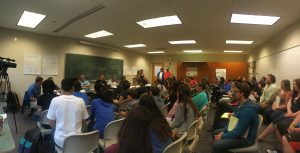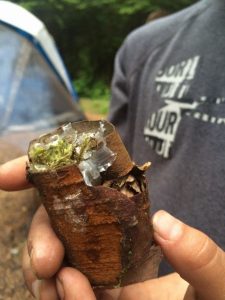
Culturally responsive teaching (CRT) was demonstrated in a multitude of ways throughout this first week of classes. Friday’s session was particularly engaging and impactful. I enjoyed being able to not only learn about but, participate in CTR with guest teachers and through the observation of master teachers speaking to the Goldbelt Heritage Academy. It was a privilege to listen to such powerhouse indigenous educators. The topic of discussion could not have been more perfect for our cohort as the essential question of the session was: “How do we embrace culture and wisdom through our resources?”
Some of the concepts reiterated by many of these master teachers were those of a pedagogy of place. Teaching about and through the culture and world view of the people who inhabit this place. The inter-connectedness of people with their environment and the animals they subsist upon was clear in the way they spoke about being thoughtful in interactions with the environment and resources. Cultural values are the lens through which each elder spoke about resources and their understanding of respect and reciprocity as caretakers of the land and its resources. Indigenous people were and are scientists. Paul Marks spoke about being taught that “Trees are the lungs of the earth”. This is just one example of how indigenous knowledge, that has been passed down for generations, holds scientific knowledge.
The elders also spoke about and demonstrated acknowledgment. Which I feel is an important skill as a teacher. To both listen to an acknowledge the words of others, especially students, and being willing to accept correction.
“Human cultures until very recently were emergent out of places; they were literally grounded in the experience of nature in particular places on the planet. If we indigenize or re-indigenize self-determination, then it will entail a re-ordering of values and signal an effort to live in a manor respective of the power, places, and persons surrounding us.”~ Daniel Wildcat

The opportunity to experience CRT strategies has been fantastic! Especially meeting Paula Savikko and Tina Pasteris. As a Juneauite who’s been involved in education I have seen these two phenomenal teacher’s work in Place-Based and Culturally-Responsive workshops. So it was great to dig into them and discuss the process of building Culturally relevant lessons.
The connections I made to Paula’s, Tina’s and Angie’s math and science lessons were those of context and “grounding your teaching in place”, both characteristics of CRT. Each of the lesson, or investigations were tied to specific geographic locations and involved the community and local culture in some way. Either as partners, or as the audience to bring authenticity and immediate relevance to what was being learned.
The math trails with Tina and the science experiment with Angie had a high level of choice. Which allowed us to draw upon class mates different strengths and background knowledge.
On a personal note (yet totally related!) I had to share this brilliant little man’s creation while camping this weekend.

It’s a fire starter. He collected and constructed on his own based on knowledge from making fire starters from household items in boy scouts last winter.
“All learning should start with what the student and community know and are using in everyday life.” – Angayuqaq Oscar Kawagley
Jasmine. I agree with you that it was a plus to not only hear about how teaching techniques can be applied but to participate in the learning techniques first hand. I very much appreciated the style of the classes that we had so far.
Also, nice fire starter. I will have to try that in the future.